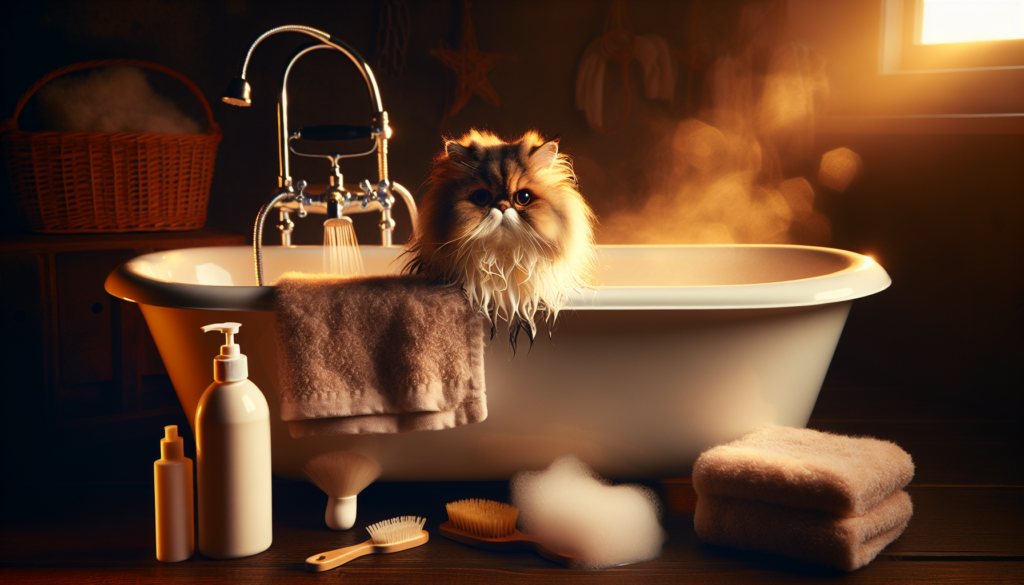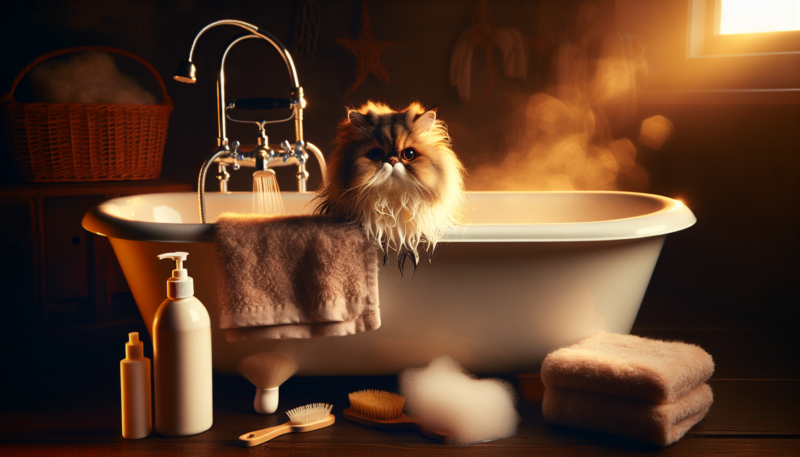If you’ve ever wondered if it’s safe to give your Persian cat a bath, the answer is a resounding yes! Despite their luxurious long fur, Persian cats can and should be bathed regularly to keep their coat clean and healthy. Contrary to popular belief, bathing a Persian cat is not as daunting as it may seem. By following a few simple steps and using gentle products, you can ensure your feline friend stays fresh and fabulous. In this article, we will guide you through the process of bathing a Persian cat, providing tips and tricks along the way to make it an enjoyable experience for both you and your furry companion. So, let’s get ready to turn bath time into a pampering session fit for a royal Persian!
Can You Bathe A Persian Cat
If you are a proud owner of a beautiful Persian cat, you may be wondering if bathing your furry friend is necessary. While cats are known for being meticulous groomers, there are certain situations where a bath can be beneficial for their overall health and well-being. In this comprehensive article, we will delve into the world of Persian cats and provide you with the knowledge and tools to confidently and safely bathe your Persian cat.
Understanding Persian Cats
Before we delve into the specifics of bathing a Persian cat, it’s important to understand their unique physical characteristics, coat type, and temperament. Persian cats are known for their stunning beauty, with their round faces, large eyes, and luscious coats. Their long, flowing hair is one of their defining features, but it also requires regular grooming and maintenance.
Physical Characteristics
Persian cats have a distinctive appearance that sets them apart from other cat breeds. They have a round head with a flat face, giving them an adorable “doll-like” appearance. Their eyes are large, expressive, and typically come in shades of blue, copper, or green. Persian cats have a broad, sturdy body with short legs and a thick tail. It is important to consider these physical characteristics when bathing a Persian cat to ensure their safety and comfort.
Coat Type and Maintenance
One of the most striking features of Persian cats is their long and luxurious coat. Their fur comes in a variety of colors and patterns, making each Persian cat unique. However, this gorgeous coat requires regular grooming to prevent matting and tangles. Regular brushing is essential to maintain the health and beauty of their coat. Additionally, periodic bathing can help remove dirt, oils, and debris that may accumulate in their fur.
Long Hair and Bathing
Due to their Long hair, Persian cats have a higher likelihood of their coat becoming dirty or tangled. Regular grooming, including bathing, can help keep their fur clean and prevent matting. Bathing a Persian cat may seem like a daunting task, but with proper preparation and technique, it can be a smooth and enjoyable experience for both you and your furry friend.
Persian Cat Temperament
Persian cats are known for their docile and gentle nature. They are often described as calm, sweet, and affectionate pets. However, each cat is unique and may have their own preferences and sensitivities. It is essential to approach bathing with patience and kindness, ensuring your Persian cat feels safe and secure throughout the process.

When Should You Bathe Your Persian Cat
Now that you have a better understanding of Persian cats, you may be wondering when it is appropriate to bathe them. While cats are generally adept at grooming themselves, there are certain situations where a bath becomes necessary. However, it is important to avoid frequent baths, as excessive bathing can strip the natural oils from their coat and lead to dryness and skin irritation.
Avoid Frequent Baths
As a general rule, Persian cats do not require frequent baths. Their coat’s natural oils help keep their fur clean and healthy. However, certain circumstances may warrant a bath, such as when your cat becomes excessively dirty, has a skin condition, or if recommended by a veterinarian. It is essential to strike a balance between keeping your Persian cat clean and maintaining the health and texture of their coat.
Recognizing the Need for a Bath
As a cat owner, it is crucial to recognize when your Persian cat may need a bath. Signs that your cat may benefit from a bath include visible dirt or debris on their fur, a foul odor, greasiness, or matting that cannot be resolved through regular grooming. Observing and evaluating your cat’s coat regularly will help you determine when it is time to give them a bath.
Consulting with a Veterinarian
If you are unsure whether your Persian cat needs a bath or have concerns about their coat or skin condition, it is always best to consult with a veterinarian. They can provide professional guidance tailored to your cat’s specific needs. A veterinarian can also recommend suitable products and techniques for bathing your Persian cat to ensure their well-being.
Preparing for a Persian Cat Bath
Proper preparation is key to ensuring a successful and stress-free bathing experience for both you and your Persian cat. By gathering the necessary supplies, creating a calm environment, and taking care of their grooming needs beforehand, you can set the stage for a relaxing and enjoyable bathing session.
Gathering the Necessary Supplies
Before bathing your Persian cat, it is important to gather all the necessary supplies to ensure a smooth process. These supplies may include:
- A shallow tub or sink: Choose a tub or sink that is appropriate in size for your cat’s comfort.
- A non-slip mat: Placing a non-slip mat at the bottom of the tub or sink can provide stability and prevent accidents.
- Pet-friendly shampoo: Select a shampoo specifically formulated for cats, avoiding harsh chemicals that may irritate their sensitive skin.
- Towels: Have several towels on hand for drying your cat after the bath.
- A gentle brush or comb: This will help remove any tangles or mats before bathing.
- Nail trimmers: Trimming your cat’s nails before the bath can help prevent scratches and provide a safer bathing experience.
- Treats and rewards: Have some treats or rewards ready to reinforce positive behavior.
Creating a Calm and Safe Environment
Persian cats thrive in calm and familiar environments, so it is important to create a peaceful space for the bath. Choose a quiet room and close any doors and windows to prevent escapes. Before bringing your cat into the bathing area, make sure the room is warm and draft-free.
Gentle Brushing
Before bathing, gently brush your Persian cat’s fur to remove any tangles or mats. This will make the bathing process easier and more comfortable for your cat. Brushing also helps distribute the natural oils in their fur, keeping it healthy and shiny.
Trimming the Nails
Trimming your Persian cat’s nails prior to the bath can help prevent scratches and injuries. Use cat-specific nail trimmers and ensure you trim only the tip of the nail, avoiding the quick. If you are unfamiliar with nail trimming, consult your veterinarian or a professional groomer for guidance.

Step-by-Step Guide to Bathing a Persian Cat
Now that you have prepared the necessary supplies and created a calm environment, it’s time to embark on the bathing process. By following these step-by-step instructions, you can ensure a successful and stress-free bath for your Persian cat.
Pre-Bath Preparations
Before placing your Persian cat in the tub or sink, make sure the water temperature is appropriate. Use warm water that is comfortable to touch, similar to the temperature you would use for a baby’s bath. Have all your supplies within reach so that you can focus on your cat during the bath.
Proper Water Temperature
The temperature of the water is crucial for the comfort of your Persian cat during the bath. As mentioned earlier, use warm water, but make sure it is not too hot or too cold to avoid discomfort. Checking the water temperature with your wrist or a thermometer can help ensure it is just right.
Using a Pet-Friendly Shampoo
Choose a cat-specific shampoo that is gentle and formulated for their sensitive skin. Avoid using human shampoos, as they often contain harsh ingredients that can cause irritation. Begin by lathering a small amount of shampoo in your hands before applying it to your cat’s fur.
Wetting the Cat’s Fur
Using a gentle stream of warm water, thoroughly wet your Persian cat’s fur. Start from the neck and work your way down their body, taking care to avoid their eyes, ears, and mouth. It may be helpful to have a handheld showerhead or a jug with a spout for a controlled water flow.
Applying the Shampoo
Once your cat is wet, apply the shampoo by gently massaging it into their fur, making sure to cover all areas. Take caution around their face and ears, using a damp washcloth to clean those areas instead. Massaging the shampoo into their coat will help remove dirt, debris, and any lingering odors.
Gentle Massage and Rinsing
After applying the shampoo, give your Persian cat a gentle massage, ensuring all areas of their body are properly cleansed. Once the shampoo is distributed throughout their coat, thoroughly rinse them with warm water. Be thorough in rinsing, as leaving behind any shampoo residue may cause skin irritation.
Drying the Cat
After rinsing, it is time to dry your Persian cat. Wrap them gently in a dry towel to remove excess water. Make sure to pat, not rub, their fur to avoid tangling or matting. If your cat tolerates it, you can also use a hairdryer on a low, warm setting to expedite the drying process. However, be cautious not to use a high heat setting or hold the dryer too close to their skin, as this can cause discomfort.
Tips for Bathing a Persian Cat
Bathing a Persian cat requires patience, gentleness, and understanding. To make the experience as pleasant as possible for both you and your furry friend, consider the following tips:
Taking Your Time
Take your time during the bathing process to ensure your cat feels comfortable and secure. Rushing through the bath can cause stress and anxiety. The key is to remain calm and patient, allowing your cat to adjust to the environment and process at their own pace.
Keeping Calm and Patient
Maintaining a calm and patient demeanor is essential when bathing your Persian cat. Cats are highly intuitive and can sense your emotions. By staying relaxed and composed, you can help create a soothing environment that minimizes stress and promotes trust.
Using Treats and Rewards
Positive reinforcement is a powerful tool when it comes to bathing your Persian cat. Offering treats and rewards before, during, and after the bath can make the experience more pleasant for your cat. This positive association will help them feel more comfortable and may even make future baths easier.
Safety Measures
During the bathing process, it is essential to prioritize safety for both you and your Persian cat. Make sure to keep a secure hold on your cat, avoiding any sudden movements that may startle them. Use caution around their face, ears, and eyes to prevent any discomfort or injury.
Drying Techniques
After the bath, take care when drying your Persian cat. Avoid rubbing the towel vigorously against their fur, which can create tangles or mats. Instead, gently pat their fur to remove excess water. If you choose to use a hairdryer, make sure to set it to a low, warm setting and keep it at a safe distance from their skin.
Dealing with Challenges
While bathing your Persian cat can be a generally smooth process, it is important to be prepared for potential challenges that may arise. By understanding how to handle nervous or aggressive behavior, matting and tangles, as well as eyebrow and facial stains, you can address these challenges effectively.
Nervous or Aggressive Behavior
Some Persian cats may exhibit nervous or aggressive behavior during baths. If your cat becomes anxious or stressed, consider using a soothing voice and gentle touches to calm them. If the behavior persists or becomes aggressive, it may be best to consult with a professional groomer or veterinarian for guidance.
Matting and Tangles
Persian cats are prone to matting and tangles due to their long hair. Regular brushing can help prevent these issues, but if matting occurs, it is important to address them before the bath. Gently tease out the mats and tangles with your fingers or a comb, being careful not to tug or pull on your cat’s fur.
Eyebrow and Facial Stains
Some Persian cats may develop stains around their eyebrows and facial area. These stains can be caused by tear ducts that overflow, resulting in a reddish or brownish discoloration. While bathing alone may not be sufficient to remove these stains, gentle cleaning with a damp cloth or specialized cleaning solution recommended by your veterinarian may help reduce their appearance.
Eye and Ear Protection
When bathing your Persian cat, it is crucial to take extra precautions to protect their eyes and ears. Ensure that water, shampoo, or any other substances do not enter their eyes or ears, as this can cause irritation or infection. Using a damp cloth to clean the face and a gentle ear cleaner for the ears can help maintain their hygiene without risking harm.
Alternative Options to Bathing
While bathing is a common method of grooming for Persian cats, it may not always be the ideal choice for every cat or situation. If your Persian cat is particularly sensitive or reluctant to baths, there are alternative options you can explore.
Waterless Shampoos
Waterless shampoos are a convenient and less stressful option for cats who dislike water or are unable to tolerate baths. These shampoos come in a spray or foam formula that can be gently applied to your cat’s fur and massaged in. They are designed to absorb oils and dirt, leaving your cat’s coat clean and fresh without the need for rinsing.
Dry Shampoo
Similar to waterless shampoos, dry shampoos are powder-based and can be applied directly to your Persian cat’s fur. These shampoos work by absorbing oils and dirt, which can then be brushed out. Dry shampoos can be a useful alternative for cats who do not tolerate baths or for spot cleaning in between baths.
Professional Grooming Services
If bathing your Persian cat proves to be too challenging or stressful, you can enlist the help of a professional groomer. Professional groomers are experienced in handling cats and have the knowledge and tools to provide a thorough and safe grooming experience. They can bathe your Persian cat, trim their fur, and address any specific grooming needs with expertise and care.
Post-Bath Care for Persian Cats
After giving your Persian cat a bath, it is important to provide post-bath care to maintain their health and comfort. By drying thoroughly, gentle brushing, preventing cold or drafts, and reinforcing positive behavior, you can ensure your Persian cat’s well-being after their bath.
Drying Thoroughly
After the bath, it is crucial to dry your Persian cat thoroughly. Using a towel, gently pat their fur to remove any remaining moisture. Ensure that their fur is completely dry, as dampness may cause discomfort and increase the likelihood of matting. If necessary, you can utilize a hairdryer on a low, warm setting at a safe distance from their skin to aid in the drying process.
Gentle Brushing
Once your Persian cat is dry, take a moment to gently brush their fur. Brushing helps distribute the natural oils in their coat, preventing matting and tangles. It also allows you to inspect their fur and skin for any potential issues, such as dryness or irritation.
Preventing Cold or Drafts
After a bath, it is crucial to keep your Persian cat warm and protected from drafts. Ensure that the bathing area is warm and free from any cold air. You can also provide a cozy spot, such as a towel-lined bed or a heated bed, where your cat can relax and dry off in comfort.
Positive Reinforcement
Once the bath is complete, reward your Persian cat with treats, praise, and affection. This positive reinforcement will create a positive association with bathing and help your cat feel more comfortable for future baths. Additionally, it strengthens the bond between you and your furry friend.
Conclusion
Bathing a Persian cat may seem like a daunting task, but with proper understanding, preparation, and techniques, it can be a manageable and rewarding experience. By considering their unique physical characteristics, recognizing the need for a bath, preparing the necessary supplies, and following a step-by-step guide, you can keep your Persian cat clean, healthy, and happy. Remember to approach each bath with patience, gentleness, and positive reinforcement, ensuring a stress-free and enjoyable experience for both you and your beloved feline companion.
